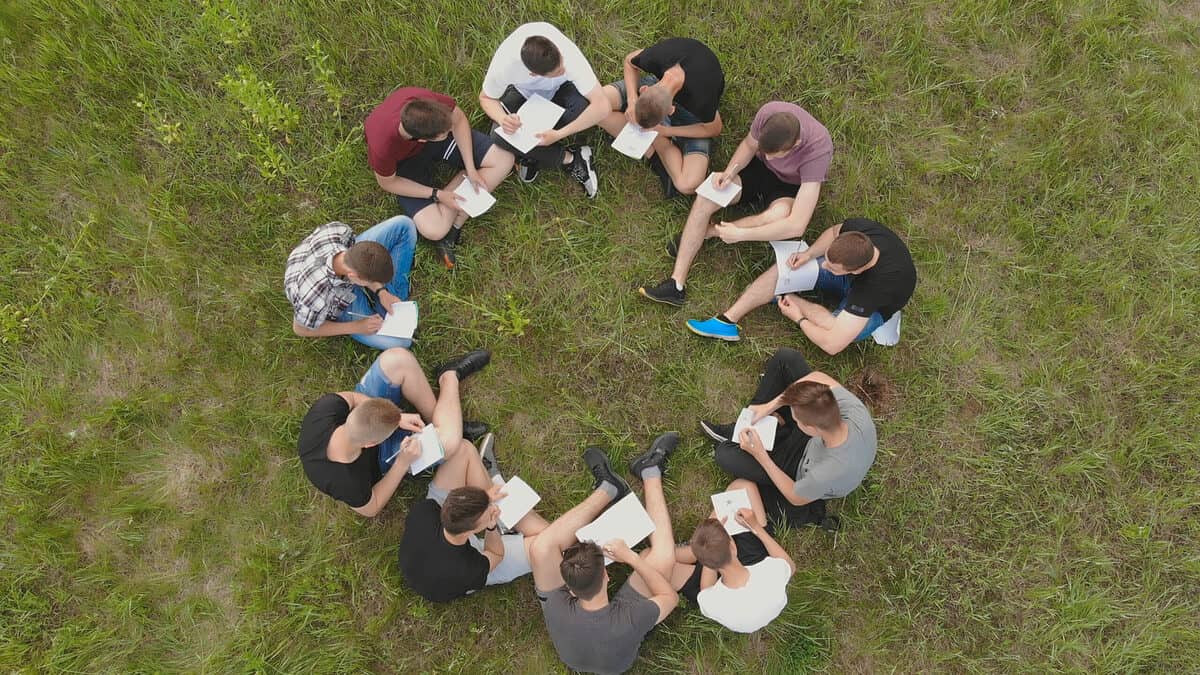Iowa boasts an enviable educational history, so it doesn't come as a surprise that the state has very old learning institutions in the heartland of America. The state's antique institutions have withstood the test of time, serving as pillars of knowledge and shaping countless generations of students.
But just how big are these schools, and what's their historical significance in the state and national education system?
This detailed review covers the ten oldest schools in the “Hawkeye State”. Explore the stories behind the region's oldest schools, where cherished traditions, pioneering educators, and the pursuit of learning continue to shape the educational landscape.
Prince of Peace Catholic School
312 S 4th St, Clinton, IA 52732
Prince of Peace Catholic School opens our list of Iowa's oldest elementary schools. The institution is famous for its comprehensive, faith-based education that has been core to its instruction programs since its early years.
Prince of Peace Elementary has been crucial to the region's Catholic education, which carries a rich history and cherished traditions. Clinton's first Catholic School opened in 1852 within the confines of a church basement. But in 1864, the institution constructed its inaugural parochial school building. And thanks to the relentless dedication of the institution's committed religious and lay teachers, Prince of Peace flourished. This trend has stayed on to its current years.
Prince of Peace embodies a symbol of educational choice, accommodating 198 students from various school districts in Iowa. The reputable Catholic school boasts a minority student enrollment of 19.2%, and its student-teacher ratio is 10:1. The facility's 19 classroom teachers guarantee individualized attention and support.
The elementary school derives financial support from contributions from Prince of Peace Parish members, tuition fees, and the school foundation. In addition, the facility offers tuition discounts to any registered, active parish members enrolling their young learners at the school.

©Monkey Business Images/Shutterstock.com
McKinley Elementary School
1610 SE 6th Street, Des Moines, IA 50315
Most of America's oldest schools are named after U.S. presidents, including Des Moines' McKinley Elementary, which got its name from William McKinley, America's 25th President. The establishment opened in 1902, but its major expansion came in 1927 when the school added an auditorium, gymnasium, and office spaces.
Before 1904, when the present building came up, scholars from the McKinley attendance area relied on Washington School. The facility's design and construction of the school followed the educational philosophy of that era. Developers aimed to create a school with eight grades, thus requiring eight rooms. Consequently, the building is arranged accordingly, with the first four grades on the first floor and grades 5-8 on the second. The kindergarten section was in a separate structure.
Since then, McKinley Elementary School has experienced tremendous growth. The institution serves PK-5 to 264 scholars, 75% from minority communities. The populace comprises 51% female students and 49% males, and a huge majority (95%) face financial limitations.
The institution hires 24 full-time educators and one counselor. Therefore, each staff member addresses about 11 scholars, which is better than the district's teacher-student ratio. This, alongside the school community's collaborative culture, has made the facility a renowned educational powerhouse in the state.
McKinley Elementary ranks 461 out of 614 in the state and is the 24th-best primary education facility in the district. The facility also ranks 592 and 583 in math and reading proficiency, with 42% of scholars passing both subjects.
Garfield Elementary School
902 E 29Th St, Davenport, IA 52803
Third on our list of ancient elementary schools is Garfield Elementary. The institution constructed its first section in 1923, functioning as a kindergarten to third-grade primary school. Between 1938 and 1939, more classrooms came up, expanding the school to accommodate an additional three grades.
Afterward, in 1950, the school added a gymnasium-auditorium, a move meant to align Garfield's facilities with the standards of newly constructed elementary schools. After these developments, the reputable institution underwent notable renovations and expansions in 1994 and 2001, incorporating a modernized media center alongside technological upgrades.
Garfield Elementary now provides a caring, safe, and nurturing environment to 468 scholars between kindergarten and fifth grade. About 61% come from minority communities, and the populace comprises 47% schoolgirls and 53% schoolboys. In addition, a majority of the students face financial limitations: 62%.
Garfield Elementary hires 32 full-time educators who collaborate with the school counselor to ensure the best environment and mindset for academic triumph. In addition, staff experience, community involvement, and student dedication have been vital to the facility's exemplary performance.
Garfield Elementary School ranks 388 among its elementary school peers in the state and is the eighth best in the Davenport Community School District. The institution also ranks 447 for math proficiency and 494 for reading proficiency, recording 62% and 56% pass rates in both subjects.

©ESB Professional/Shutterstock.com
Lincoln Elementary School
300 Teeters Court, Iowa City, IA 52246
Lincoln Elementary School sums up the elementary school's section. Construction of the reputable public school commenced in 1925 and concluded in 1926. Classes commenced in the same year on October 4, with S.D. Whiting served as the school board president. It was named after the esteemed President Abraham Lincoln.
During Lincoln School's initial construction, the facility consisted of only two rooms on the current classroom level. The school also had a stage that served as a kindergarten and gymnasium alongside an unequipped kitchen. In addition, the main entrance faced River Street, while its backside faced Main Street, which was subsequently renamed Teeters Court in honor of Professor and Mayor Teeters. But in an interesting turn of events, the back of the school is now considered the front.
Lincoln School's official dedication ceremony occurred on October 8, 1926, and the school has grown tremendously.
Lincoln Elementary School serves a student population of 226 from kindergarten to sixth grade. The populace is predominantly male, comprising 54% schoolboys and 46% schoolgirls. In addition, 41% come from minority communities, and learners with financial limitations form 24%.
The diverse student population at Lincoln Elementary relies on 16 full-time educators. This faculty team comprises qualified staff with remarkable teaching experience.
Lincoln Elementary School is among the best-performing schools in the state. For instance, the facility ranks 6th best out of the 614 ranked elementary schools in the state. It's also the best in the Iowa City Community School District in examination performance and student college preparation, and ranks sixth and tenth in reading and math proficiency. Interestingly, both subjects recorded a 92% pass rate.
Dubuque Senior High School
1800 Clarke Dr, Dubuque, Iowa 52001
Dubuque High School is the oldest high school facility on our list. The institution dates back to 1858, initially within the Prescott Apartments. A year later, the Board of Education purchased what is now Immaculate Conception Academy. The school also acquired Turner's Hall in 1865, initially serving as the High School Annex and presently the Dubuque Boys' Club.
The board later purchased a building at 15th and Locust in 1895. But insufficient capacity forced some students to attend classes at the Annex. Finally, on February 23, 1923, the establishment known as Dubuque Senior High School opened its doors and has been the students' educational home ever since.
Dubuque Senior High serves 1,483 scholars in grades 9-12. The gender distribution is almost balanced, comprising 49% female and 51% male scholars, and the facility has a total minority enrollment of 22%. In addition, the school caters to economically disadvantaged scholars, who form 37% of the total enrollment. About 31% rely on the Free Lunch Program, while those on the reduced-Price Lunch Program make up 6% of the student body.
These brilliant students owe their success to the school's 135 full-time equivalent Teachers. This means each faculty member serves 11 scholars, an impressive tutor-student ratio that is way better than the district's average.
Dubuque Senior High ranks 7,567th nationally, 69th statewide, and fourth best in the Dubuque metro area. In addition, the school boasts an impressive 86% graduation rate.

©NDAB Creativity/Shutterstock.com
Central High School
1120 Main St, Davenport, Iowa 52803
Since 1861, high schools in Davenport have been housed in various locations. The longest-standing site was situated approximately where Eighth, Seventh, and Iowa Streets intersect. Davenport and Scott County's history notes that the original Central High building opened in 1875 and gradually expanded. But eventually, it couldn't accommodate the growing student populace, necessitating some crucial developments.
In 1900, the institution purchased the Griswold College, and after four years, the contract to construct the new school was awarded. Groundbreaking on the new site occurred on October 1, 1904, and in June 1905, Superintendent JB Young laid the cornerstone.
Building construction ended exactly a year and a half later, marking the commencement of classes at Central, then called Davenport, High School. George Edward Marshall was the first principal and served between 1907 and 1932.
Central High School began by offering seven courses of study, each spanning 40 weeks. These courses covered vast subjects such as English, Latin, German, science, manual training for industrial and technical careers, commercial business, and domestic science.
Central High School has experienced numerous additions and renovations to enhance the original building. Notable milestones include the 1915 acquisition of Kemper Hall, the establishment of the JROTC program in 1919, the 1930 construction of the George Marshall Gym, and the introduction of the first Minstrel (Variety) Show in 1939.
East High School
815 E 13th St, Des Moines, IA 50316
Des Moines' East High School was established in 1861. The school is one of Iowa's largest educational institutions, accommodating one of the state's highest populations.
Since its early days, the school has maintained a steadfast commitment to the service of humanity and continues to take pride in its rich history. The institution is also renowned for its illustrious alumni, and its graduates have achieved remarkable success in various fields.
East High School serves a total enrollment of 2,204 in grades 9-12. Female scholars form 46%, while their male counterparts form 54%. The school's location makes it accessible to students from diverse ethnic and financial backgrounds. Thus, the institution boasts a 71% minority enrollment and 82% face financial limitations. But the school provides free and reduced-priced meal plans.
East High's staff team comprises 97 full-time educators. But, despite the high student-teacher ratio, the dedicated staff and leadership do everything to ensure a family environment for optimal enrichment.
East High ranks 13,383 out of 17,843 high schools in the country and 218 out of 313 in Iowa. In addition, the school ranks 29th in the Des Moines metro area and is the third-best facility in the district.
Notable East High Alumni
East High is one of Iowa's oldest schools; because of this, it boasts a few impressive alumni. These alumni are:
- Marilyn Maye, jazz musician and cabaret singer
- Pauline Brown Humphrey, cosmetologist who started a cosmetology school in Iowa
- Lorri Bauman, first women's NCAA basketball player to score 3,000 points
- Gregory Alan Williams, actor
- Stephen Kline, artist, designer, and photographer

©WorldStockStudio/Shutterstock.com
Loras College
1450 Alta Vista, Dubuque, IA 52004
Loras College, the oldest higher learning facility on our list, is the brainchild of the Most Rev. Mathias Loras, the first bishop of Dubuque. The facility started operating in 1839 and was initially known as St. Raphael Seminary. The founder thought of educating young men for the priesthood while providing higher education opportunities to the local community.
Loras College has used various names since its inception, including St. Raphael Seminary, Mt. St. Bernard, St. Joseph College, Dubuque College, and Columbia College. The institution eventually adopted the current name during its 1939 centennial. Since then, the institution has remained dedicated to undergraduate programs.
Later, in 1963, Loras College established its Graduate Division to offer Master of Arts degrees in selected fields. This move addressed the need for post-baccalaureate education in the area. In 1971, Loras College upgraded into a coeducational institution, introducing Associate of Arts and Associate of Science degrees. The school initiated the Division of Community Education in 1975.
Today, Loras College takes pride in being the state's oldest higher education institution. The facility caters to 1,310 undergraduate scholars, a population of 57% Males and 43% Females, with a 17% Minority Enrollment rate.
Loras College has one of the most impressive four-year graduation rates, at 60%. The institution also has a student-faculty ratio of 11:1, and 46% of classes have under 20 Students.
In terms of rankings, Loras College thrives in multiple categories. However, the institution ranks 10th among the Regional Colleges in the Midwest and falls 6th among the Best Value Schools. Finally, the facility ranks in position 205 in Engineering Programs.
Notable Loras College Alumni
Loras College has an impressive roster of alumni. Some notable names include:
- Red Faber, pitcher in the Baseball Hall of Fame
- Frank Quilici, former player for the Minnesota Twins
- Father Aloysius Schmitt, the first U.S. chaplain killed in World War Two
- Rod Blum, former U.S. Representative
- George Guthridge, speculative fiction author
- Darin LaHood, U.S. Representative
- Thomas P. Sullivan, U.S. Attorney under President Jimmy Carter
- Chris Jans, head basketball coach for Mississippi State
Iowa Wesleyan University
601 North Main St Mt Pleasant, IA 52641
Following close by is Iowa Wesleyan University, an institution with a rich educational history dating back to 1842, its founding year. Its original name was Mt. Pleasant Literary Institute, before later changing to Mt. Pleasant Collegiate Institute. Aristides Joel Priest Huestis oversaw the construction of the Institute Building, now called Pioneer Hall.
In 1845, the institution commenced its first classes under the leadership of President Huestis and Professor Johnson Pierson. In 1853, James Harlan became the President. James is notable for securing funds to build Old Main and expanding the curriculum. Two years later, in 1855, the institution changed its name to Iowa Wesleyan University, highlighting its affiliation with the Methodist Episcopal Church.
Since then, the facility has maintained its current name. The facility has a 90% acceptance rate and 14% four-year graduation rate. The institution also boasts a 14:1 student/faculty ratio and 62% of classes serve fewer than 20 scholars.
Fast forward, and this university is still on the original 60-acre parcel and caters to an undergraduate population of 748 and a graduate population of 66. About 42% come from minority communities, making it one of the state's most inclusive facilities.
According to the latest rankings, the school falls in position 58 out of 76 Midwest regional colleges. The school also ranks 60th among the top performers in social mobility. The institution maintains its close connection with the United Methodist Church, aiming to reflect the church's spiritual values.

©Monkey Business Images/Shutterstock.com
Grinnell College
1115 8th Avenue Grinnell, IA 50112
Grinnell College closes our list of the oldest schools in Iowa. The private liberal arts and sciences college began operating in 1846 and has continually fostered a community that encourages intellectual exploration. In addition, the institution has been known for providing personalized guidance throughout its history, assisting students to delve deeper into their interests and pursue their passions.
Grinnell College was initially called Iowa College. However, the institution's origins trace back to the arrival of young missionaries from Andover and Yale seminaries in the late 1830s. In 1846, the institution's Board of Trustees was established, and the school commenced preparatory classes two years later.
By 1850, the school had attained college-level classes. The school's first graduates, William and John Windsor, earned their B.A. degrees in 1854.
Grinnell College now ranks among the country's largest undergraduate programs, serving a total population of 1,748 scholars. The masses comprise 52% females and 48% males, and 25% constitute scholars from minority communities.
The college has an 82% four-year graduation rate, and the scholar-faculty ratio stands at 9:1. In addition, about 63% of classes in Grinnell have less than 20 learners, a factor that has been crucial to the facility's impressive rankings.
Grinnell College ranks 15th among the National Liberal Arts Colleges and 8th among the Best Value Schools.
Notable Grinnell College Alumni
Grinnell College boasts a nice roster of notable alumni, including:
- Robert Noyce, co-founder of Intel
- Gary Cooper, actor
- Florin Citu, former Prime Minister of Romania
- Peter Coyote, actor and director
- John Garang, former Vice President of Sudan
- Herbie Hancock, Grammy award-winning jazz musician
- Emily Bergl, actress
- Sen Katayama, co-founder of the Japan Communist Party
- Harry Hopkins, architect of the New Deal
- Charles Rawson, former U.S. Senator
Pick the Perfect School For Your Child
Like most parents, you want an institution reputable for transforming lives for generations. Such schools boast rich traditions, established reputations, and impressive alumni networks. But, with numerous options to choose from, it can be hard to pick the right option.
To get it right, you must prioritize your considerations. Generally, the decision is preference based, so consider your child's unique educational needs, innate talents, and capabilities. Also, check out the school's quality of education, evident in multiple factors like student-teacher ratio, percentage of qualified tutors, and the kind of programs they offer.
With all these in mind, you won't have difficulty finding the perfect institution.
The image featured at the top of this post is ©Monkey Business Images/Shutterstock.com.
